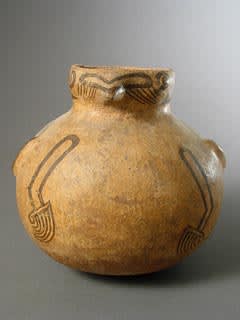Cocle Terracotta Avian Effigy Vessel, 1200 CE - 1400 CE
Terracotta
8.125
PF.1353
Further images
Archaeological excavations in the Cocle Province located in Central Panama have revealed that an ancient civilization once inhabited these lands. The findings suggested that the so-called Cocle culture arose around...
Archaeological excavations in the Cocle Province located in Central Panama have revealed that an ancient civilization once inhabited these lands. The findings suggested that the so-called Cocle culture arose around 500 A.D. and lasted until about 1000 A.D. Although their dating is roughly contemporaneous with the Diquis culture to the north in modern day Costa Rica, the art they left behind suggests that they were a unique, independent civilization. Cocle art, which consists primarily of unslipped or buff slipped pottery and terracotta sculptures, is distinguished by their polychrome hues and lively asymmetrical motifs which often include animal themes.
With the bold abstraction characteristic of Cocle art, the potter has transformed this vessel into a majestic bird. Without losing the generous round shape of the pot, he has added minimal but essential details--wings, a tail, and a beak--that are unmistakably bird-like. In ancient Panama birds were sometimes worshipped as gods, nature spirits with power over the fate of man. Looking at this regal creature, we do not doubt for a moment his divine status.
With the bold abstraction characteristic of Cocle art, the potter has transformed this vessel into a majestic bird. Without losing the generous round shape of the pot, he has added minimal but essential details--wings, a tail, and a beak--that are unmistakably bird-like. In ancient Panama birds were sometimes worshipped as gods, nature spirits with power over the fate of man. Looking at this regal creature, we do not doubt for a moment his divine status.







